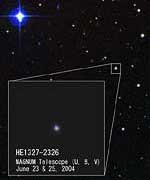The first object in the night sky most of us ever saw, the Moon remains a mystery. Haunted by poets, looked upon by youngsters in love, studied intensely by astronomers for four centuries, examined by geologists for the last 50 years, walked upon by twelve humans, this is Earth’s satellite.
And as we look towards the Moon with thoughts of setting up a permanent home there, one new question is paramount: does the Moon have water? Although none has been definitely detected, recent evidence suggests that it’s there.
Why should there be water on the Moon? Simply for the same reason that there’s water on Earth. A favorite theory is that water, either as water by itself or as its components of hydrogen and oxygen, was deposited on Earth during its early history–mostly during a period of “late heavy bombardment” 3.9 billion years ago–by the impacts of comets and asteroids. Because the Moon shares the same area of space as Earth, it should have received its share of water as well. However, since it has only a tiny fraction of Earth’s gravity, most of the Moon’s water supply should have evaporated and drifted off into space long ago. Most, but perhaps not all.
In ancient times, observers commonly thought the Moon had abundant water–in fact, the great lava plains like Mare Imbrium were called maria, or seas. But when Neil Armstrong and Buzz Aldrin landed on the Moon in 1969, they stepped out not into the water of the Sea of Tranquillity, but onto basaltic rock. No one was surprised by that–the idea of lunar maria had been replaced by lava plains decades earlier.
As preparations were underway in the mid 1960s for the Apollo program, questions about water on the Moon were barely on the radar screen. Geologists and astronomers were divided at the time as to whether the lunar surface was a result of volcanic forces from beneath, or cosmic forces from above. Grove Carl Gilbert in 1893 already had the answer. That famous geologist suggested that large asteroidal objects hit the Moon, forming its craters. Ralph Baldwin articulated the same idea in 1949, and Gene Shoemaker revived the idea again around 1960. Shoemaker, almost alone among geologists of his day, saw the Moon as a fertile subject for field geology. He saw the craters on the Moon as logical impact sites that were formed not gradually in eons, but explosively in seconds.
The Apollo flights confirmed that the dominant geological process on the Moon is impact-related. That discovery, in turn, ushered in a new question: Since Earth’s water was probably delivered largely by comets and asteroids, could this process have done the same for the Moon? And could some of that water still be there?
In 1994, the SDI-NASA Clementine spacecraft orbited the Moon and mapped its surface. In one experiment, Clementine beamed radio signals into shadowed craters near the Moon’s south pole. The reflections, received by antennas on Earth, seemed to come from icy material.
That makes sense. If there is water on the Moon, it’s probably hiding in the permanent shadows of deep, cold craters, safe from vaporizing sunlight, frozen solid.
So far so good, but… the Clementine data were not conclusive, and when astronomers tried to find ice in the same craters using the giant Arecibo radar in Puerto Rico, they couldn’t. Maybe Clementine was somehow wrong.
In 1998, NASA sent another spacecraft, Lunar Prospector, to check. Using a device called a neutron spectrometer, Lunar Prospector scanned the Moon’s surface for hydrogen-rich minerals. Once again, polar craters yielded an intriguing signal: neutron ratios indicated hydrogen. Could it be the “H” in H2O? Many researchers think so.
Lunar Prospector eventually sacrificed itself to the search. When the spacecraft’s primary mission was finished, NASA decided to crash Prospector near the Moon’s south pole, hoping to liberate a bit of its meager layer of water. Earth’s satellite might briefly become a comet as amounts of water vapor were released.
Lunar Prospector crashed, as planned, and several teams of researchers tried to detect that cloud, but without success. Either there was no water, or there was not enough water to be detected by Earth-based telescopes, or the telescopes were not looking in precisely the right place. In any event, no water was found from Prospector’s impact.
In 2008, NASA plans to send a new spacecraft to the Moon: the Lunar Reconnaissance Orbiter (LRO), bristling with advanced sensors that can sense water in at least four different ways. Scientists are hopeful that LRO can decide the question of Moon water once and for all.
Our interest is not just scientific. If we are indeed to build a base on the Moon, the presence of water already there would offer a tremendous advantage in building and running it. It’s been 35 years since we first set foot on the Moon. Now ambitious eyes once again look toward our satellite not just as a place to visit, but as a place to live.
Original Source: Science@NASA

